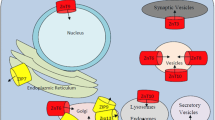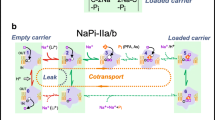Abstract
All of the members of this family are thought to facilitate zinc efflux from the cytoplasm either into various intracellular compartments (endosomes, secretory granules, synaptic vesicles, Golgi apparatus, or trans-Golgi network) or across the plasma membrane. Thus, these transporters are thought to help maintain zinc homeostasis and facilitate transport of zinc into specialized intracellular compartments. Counterparts of the SLC30 family are found in all organisms. Most of the members of this class are predicted to have 6 transmembrane domains with both N- and C-termini on the cytoplasmic side of the membrane. Expression of rodent Znt1, Znt2 or Znt4 cDNAs in mammalian cells can confer resistance to zinc toxicity. Loss of function of the mouse Znt1 is embryonic lethal, loss of mouse Znt3 prevents accumulation of zinc in synaptic vesicles, nonfunctional mouse Znt4 (lethal milk) results in zinc-deficient milk, and Znt5-null mice display bone abnormalities and heart failure. No mutations in human counterparts of any of the members of the SLC30 family have been described.



Similar content being viewed by others
References
Palmiter RD, Findley SD (1995) Cloning and functional characterization of a mammalian zinc transporter that confers resistance to zinc. EMBO J 14:639–649
Palmiter RD, Cole TB, Findley SD (1996) ZnT-2, a mammalian protein that confers resistance to zinc by facilitating vesicular sequestration. EMBO J 15:1784–1791
Kamizono A, Nishizawa M, Teranishi Y, Murata K, Kimura A (1989) Identification of a gene conferring resistance to zinc and cadmium ion in the yeast Saccharomyces cerevisiae. Mol Gen Genet 219:161–167
Conklin DS, Culbertson MR, Kung C (1994) Interactions between gene products involved in divalent cation transport in Saccharomyces cerevisiae. Mol Gen Genet 244:303–311
Palmiter RD, Cole TB, Quaife CJ, Findley SD (1996) ZnT-3, a putative transporter of zinc into synaptic vesicles. Proc Natl Acad Sci USA 93:14934–14939
Huang, L, Gitschier J (1997) A novel gene involved in zinc transport is deficient in the lethal milk mouse. Nat Genet 17:292–297
Piletz JE, Ganschow RE (1978) Zinc deficiency in murine milk underlies expression of the lethal milk (lm) mutation. Science 199:181–183
Erway LC, Grider A Jr (1994) Zinc metabolism in lethal-milk mice: otolith, lactation, and aging effects. J Hered 75:480–484
Kambe T, Narita H, Yamaguchi-Iwai Y, Hirose J, Amano T, Sugiura N, Sasaki R, Iwanaga T, Nagao M (2002) Cloning and characterization of a novel mammalian zinc transporter, zinc transporter 5, abundantly expressed in pancreatic beta cells. J Biol Chem 277:19049–19055
Huang L, Kirschke CP, Gitschier J (2002) Functional characterization of a novel mammalian zinc transporter, ZnT6. J Biol Chem 277:26389–26395
Kirschke CP, Huang L (2002) ZnT7, A novel mammalian zinc transporter, accumulates zinc in the Golgi apparatus. J Biol Chem 278:4096–4102
Gaither LA, Eide DJ (2001) Eukaryotic zinc transporters and their regulation. Biometals 14:251–270
Nies DH, Silver S (1995) Ion efflux systems involved in bacterial metal resistances. J Ind Microbiol 14:186–199
Paulsen IT, Saier MH Jr (1997) A novel family of ubiquitous heavy metal ion transport proteins. J Membr Biol 156:99–103
Guffanti AA, Wei Y, Rood SV, Krulwich TA (2002) An antiport mechanism for a member of the cation diffusion facilitator family: divalent cations efflux in exchange for K+ and H+. Mol Microbiol 45:145–153
MacDiarmid CW, Milanick MA, Eide DJ (2002) Biochemical properties of vacuolar zinc transport systems of Saccaromyces cerevisiae. J Biol Chem 277:39187–39194
Gunshin J, MacKenzie B, Berger UV, Gunshin Y, Romero MF, Boron WF, Nussberger S, Gollan JL, Hediger MA (1997) Cloning and characterization of a mammalian proton-coupled metal-ion transporter. Nature 388:482–488
McMahon RJ, Cousins RJ (1998) Regulation of the zinc transporter ZnT-1 by dietary zinc. Proc Natl Acad Sci USA 95:4841–4846
Liuzzi JP, Blanchard RK, Cousins RJ (2001) Differential regulation of zinc transporter 1, 2 and 4 mRNA expression by dietary zinc in rats. J Nutr 131:46–52
Sekler I, Moran A, Hershfinkel M, Dori A, Margulis A, Birenzweig N, Nitzan Y, Silverman WF (2002) Distribution of the zinc transporter ZnT-1 in comparison with chelatable zinc in the mouse brain. J Comp Neurol 447:201–209
Langmade SJ, Ravindra R, Daniels PJ, Andrews GK (2000) The transcription factor MTF-1 mediates metal regulation of the mouse ZnT1 gene. J Biol Chem 275:34803–34809
Tsuda M, Imaizzumi K, Katayama T, Kitagawa K, Wanaka A, Tohyama M, Takagi T (1997) Expression of the zinc transporter gene, ZnT-1, is induced after transient forebrain ischemia in the gerbil. J Neurosci 17:6678–6684
Kobayashi T, Beuchat M-H, Lindsay SF, Palmiter RD, Sakuraba H, Parton RG, Gruenberg J (1999) Late endosomal membranes rich in lysobisphosphatidic acid regulate cholesterol transport. Nat Cell Biol 2:113–118
Wenzel HJ, Cole TB, Born DE, Schwartzkroin PA, Palmiter RD (1997) Ultrastructural localization of zinc transporter 3 (ZnT-3) to synaptic vesicle membranes within mossy fiber boutons in the hippocampus of mouse and monkey. Proc Natl Acad Sci USA 94:12676–12681
Cole TB, Wenzel HJ, Kafer KE, Schwartzkroin PA, Palmiter RD (1999) Elimination of zinc from synaptic vesicles in intact mouse brain by disruption of the ZnT3 gene. Proc Natl Acad Sci USA 96:1716–1721
Kantheti P, Qiao X, Diaz ME, Peden AA, Meyer GE, Carskadon SL, Kapfhamer D, Sufalko D, Robinson MS, Noebels JL, Burmeister M (1998) Mutation in AP-3 delta in the mocha mouse links endosomal transport to storage deficiency in platelets, melanosomes and synaptic vesicles. Neuron 21:111–122
Cole TB, Martyanova A, Palmiter RD (2001) Removing zinc from synaptic vesicles does not impair learning, memory, or sensorimotor functions in the mouse. Brain Res 891:253–265
Cole TB, Robbins CA, Wenzel HJ, Schwartzkroin PA, Palmiter RD (2000) Seizures and neuronal damage in mice lacking vesicular zinc. Epilepsy Res 39:153–169
Lee J-Y, Cole TB, Palmiter RD, Koh J-Y (2000) Accumulation of zinc in degenerating hippocampal neurons on ZnT3-null mice after seizures: evidence against synaptic vesicle origin. J Neurosci 20:RC79 (1–5)
Lopantsev V, Wenzel HJ, Cole TB, Palmiter RD, Schwartzkroin PA (2003) Lack of vesicular zinc in mossy fibers does not affect synaptic excitability of CA3 pyramidal cells in zinc transporter 3 knockout mice. Neuroscience 116:237–248
Cherny RA, Atwood CS, Xilinas ME, Gray DN, Jones WD, McLean CA, Barnham KJ, Volitakis I, Fraser FW, Kim Y, Huang X, Goldstein LE, Moir RD, Lim JT, Beyreuther K, Zheng H, Tanzi RE, Masters CL, Bush AI (2001) Treatment with a copper-zinc chelator markedly and rapidly inhibits β-amyloid accumulation in Alzheimer's disease transgenic mice. Neuron 30:665–676
Lee J-Y, Cole TB, Palmiter RD, Suh SW, Koh J-Y (2002) Contribution by synaptic zinc to the gender-disparate plaque formation in human Swedish mutant APP transgenic mice. Proc Natl Acad Sci USA 99:7705–7710
Murgia C, Vespignani I, Cerase J, Nobili F, Perozzi G (1999) Cloning, expression and vesicular localization of zinc transporter Dri27/ZnT4 in intestinal tissue and cells. Am J Physiol 277:G1231–1239
Michalczyk AA, Allen J, Blomeley RC, Ackland ML (2002) Constitutive expression of hZnT4 zinc transporter in human breast epithelial cells. Biochem J 364:105–113
Kelleher SL, Lonnerdal B (2002) Zinc transporters in the rat mammary gland respond to marginal zinc and vitamin A intakes during lactation. J Nutr 132:3280–85
Bleck O, Ashton GH, Mallipeddi R, South AP, Wittock NV, McLean WH, Atherton DJ, McGrath JA (2001) Genomic localization, organization and amplification of the human zinc transporter protein gene, ZNT4, and exclusion as a candidate in different variants of acrodermatidis enteropathica. Arch Dermatol Res 293:392–396
Inoue K, Matsuda K, Itoh M, Kawaguchi H, Tomoike H, Aoyagi T, Nagai R, Hori M, Nakamura Y, Tanaka T (2002) Osteopenia and male-specific sudden cardiac death in mice lacking a zinc transporter gene, Znt5. Hum Mol Genet 11:1775–84
Cragg RA, Christie GR, Phillips SR, Russi RM, Kury S, Mathers JC, Taylor PM, Ford D (2002) A novel zinc-regulated human zinc transporter, hZTL1, is localized to the enterocyte apical membrane. J Biol Chem 277:22789–97
Li L, Kaplan J (2000) The yeast gene MSC2, a member of the cation diffusion facilitator family, affects cellular distribution of zinc. J Biol Chem 275:5036–5043
Author information
Authors and Affiliations
Corresponding author
Rights and permissions
About this article
Cite this article
Palmiter, R.D., Huang, L. Efflux and compartmentalization of zinc by members of the SLC30 family of solute carriers. Pflugers Arch - Eur J Physiol 447, 744–751 (2004). https://doi.org/10.1007/s00424-003-1070-7
Received:
Accepted:
Published:
Issue Date:
DOI: https://doi.org/10.1007/s00424-003-1070-7




